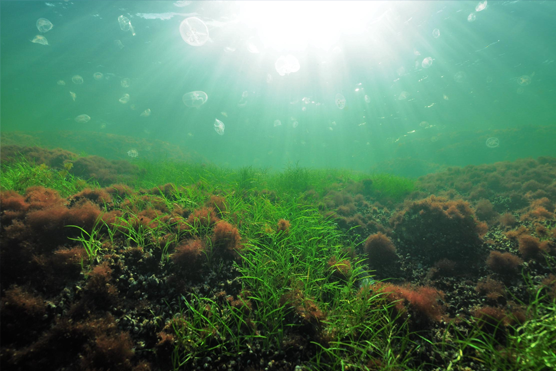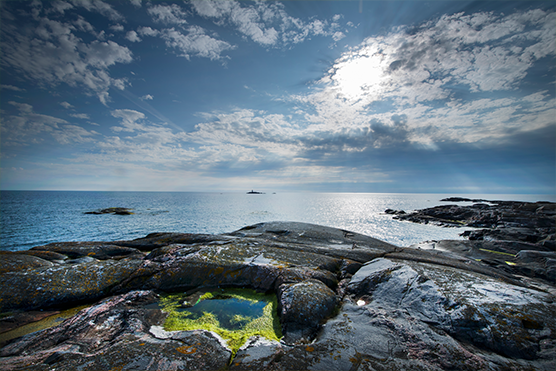Tackling dispersed microplastics
SYKE has contributed to the plastics roadmap of Finland and the measures it defines for reusing, recycling and managing plastics, and the development of waste and recycling systems.
SYKE began to sample the Baltic Sea for microplastics in 2012 as part of a pilot project for the Marine Strategy Framework Directive of the EU. SYKE granted seed funding for an internal project in 2015. This kickstart resulted in a report and a Policy Brief in 2017, which were followed by numerous scientific publications (e.g. Uurasjärvi et al., 2020) and practical reports.
SYKE research on microplastics has made it a popular partner in national and international research projects as well as commissioned projects. SYKE’s research and applications range from ecology and food-webs to technical and policy solutions. SYKE leads the mesocosm research within the Aquacosm network organized by the European Union, and novel research on e.g. textiles and circular economy.
Microplastics make their way into the food web
SYKE’s projects produced a consolidated summary knowledge base of microplastics flows and sources. The early projects studied recycled plastics and bioplastics as sources of microplastics, confirming their presence and discovered that stormwaters transported the particles to the Baltic. Now we have an understanding of microplastics loads to the Baltic Sea and the role of waste-based bioplastics and urban runoff. SYKE has importantly generated an understanding of the abundance, type and transfer of microplastics in food webs.
Artificial turf as source of microplastics
SYKE has repeatedly appeared in the popular media, including TV, radio and newspapers, reaching out to consumers on the issue. SYKE has also found ways of connecting industrial, ecological and governance processes. Consequently, awareness of littering and microplastics has increased, and new collaborative openings have emerged with e.g. the textile industry and the artificial turf, food and health industries.
For more on the impacts:
-
Microplastics – a growing environmental risk (Policy Brief)
-
Uurasjärvi et al. 2019, Microplastic concentrations, size distribution, and polymer types in the surface waters of a northern European lake
-
SYKE Report 9/2020: Road traffic is a significant source of microplastics (report includes abstract in English)
-
Setälä, O., Norkko, J., & Lehtiniemi, M. (2016). Feeding type affects microplastic ingestion in a coastal invertebrate community. Marine pollution bulletin, 102(1), 95-101.
-
Lares, M., Ncibi, M. C., Sillanpää, M., & Sillanpää, M. (2018). Occurrence, identification and removal of microplastic particles and fibers in conventional activated sludge process and advanced MBR technology. Water research, 133, 236-246.
Mapping the treasures of the sea to better protect them

© Mats Westerblom / Metsähallitus.
SYKE coordinates and partially funds the national marine inventory and mapping program (VELMU) that was launched in 2004. The data and analyses of VELMU have been used to improve the current Finnish Marine Protected Area network, and in compiling the national red lists of threatened habitats and species. VELMU data have also been used in localizing areas suitable or not for wind power, aquaculture, and marine mineral extraction in a Strategic Research Council funded project SmartSea.
The original goal of VELMU was to collect bio- and geodiversity data to support conservation and sustainable use of the Finnish marine areas. To date, VELMU has produced a database of 160,000 observations on species and habitats. Hundreds of models and layers have been prepared resulting in maps that show where the most valuable .
A mapping program that works
VELMU data have been used in designating four Ecologically or Biologically Significant Marine Areas according to the Convention on Biological Diversity (CBD) in the northern Baltic Sea. Using the EBSA criteria, VELMU also described Finland’s national Ecologically Significant Marine Areas. Spatial planners make use of the data layers, notably as important background data for developing EU-level marine spatial planning in Finland.
VELMU data and experts contribute to HELCOM work. VELMU was used as an example of a functioning mapping program by the HELCOM community.
Dazzling the public
In 2019, the Coordination Group of Marine Spatial Planning in Finland requested VELMU to produce a data layer that would integrate all VELMU data into one single spatial layer, which in turn could be used as background material for preparing national marine spatial plans.
VELMU came up with EMMA, a report describing Finnish Ecologically Significant Marine Underwater Areas in an integrated way. The general public was targeted with a 300-page book called Meren aarteet (Treasures of the Sea), an Atlas, and a textbook of Finnish marine biodiversity. WWF Finland awarded its Nature Book of the Year Prize to Meren aarteet in 2018.
For more on the impacts:
Developing oil spill response
The amount of oil transported in the Baltic has increased significantly, particularly in the Gulf of Finland, with the opening of new Russian oil harbours. About 45 000 vessels and 8 000 tankers sail the Baltic sea every year. Biggest oil cargo can be even 150 000 tons. Through the Convention on the Protection of the Marine Environment of the Baltic Sea Area (HELCOM), Baltic coastal states have committed to cooperate to effectively respond to any oil spills by collecting the oil with vessels specially equipped for this purpose.
SYKE’s research and expertise support the protection and use of the sensitive environments in the Arctic regions. SYKE is extensively involved in the Arctic Council's work and in various projects in northern areas and carries also out regular research of the Arctic marine environment. Together with its partners SYKE has been developing a system for the real-time observation of underwater oil spills and a strategic tool for choosing oil spill response methods.
For example, in the GRACE consortium project coordinated by SYKE the focus was on developing, comparing and evaluating the effectiveness and environmental effects of different oil spill response methods in a cold climate. The results of the project were made available for use to international organisations planning and carrying out cross-border oil spill response cooperation in Arctic sea areas.
The expected impacts are to mitigate negative impacts of oil pollution and response activities on the marine environment, coastal economies and communities, better decision support tools for oil spill response strategy in different conditions, to improve the integration between the scientific community and relevant government agencies charged with dealing with pollution including cross-border and trans-boundary co-operation, better business potential for companies producing oil response equipment and monitoring services and increased public acceptance of off shore activities through a thorough environmental assessment of the environmental impacts of different response methods.
For more on the impacts:
Gulf of Finland co-operation

© Riku Lumiaro
Finland, Estonia and Russia have since 1960s worked together to improve the state of the marine environment of the Gulf of Finland. This co-operation stepped up when SYKE took the responsibility for coordinating the Gulf of Finland Years 1996 and 2014. They were a great success involving high-level participation, a wide range of activities in all countries, and receiving much publicity. Since then SYKE has acted as an engine and focal point of this trilateral co-operation, including housing its secretariat.
The Gulf of Finland Year 2014 ended with the signing of a Declaration which outlined the key steps to safeguard the sustainable use of the Gulf, and which has since then been renewed. The co-operation has continued at high political level, which has ensured progress and facilitated individual projects, such as upgrading the wastewater treatment plant of St. Petersburg, which had an enormous positive effect on the wellbeing of the marine ecosystem of the Gulf. Indeed, the first comprehensive assessment of the entire Gulf of Finland in 2016 showed that the state of the eastern parts of the Gulf had improved.
Regular assessments such as this are one important outcome of the scientific co-operation under the Declaration. SYKE has actively enhanced and deepened all aspects of this co-operation. As a result, nine topics of research have been identified and put to practice, co-operation in monitoring has been established and the monitoring methods and results have been harmonized and streamlined. Furthermore, Gulf of Finland Science Days are organised on a regular basis, supported by high-level attendance.
The co-operation has not only led to better understanding of the marine environment of the Golf of Finland but also produced concrete measures to improve its state, and brought together scientists, decision-makers and citizens to this end. The efficient network created holds promises for continued success.
For more on the impacts:
The SmartSea project
SmartSea – Gulf of Bothnia as a Resource for Sustainable Growth – is a six year (2015–2021) project funded by the Strategic Research Council of the Academy of Finland, which involves seven institute and university partners in addition to SYKE. In the project, SYKE is responsible for ecological and conservation aspects, as well as taking them into account in maritime spatial planning.
SmartSea provides science-based guidance and new innovations for Blue Growth, i.e. sustainable use of Finland's marine resources, in a changing climate. In particular, the project examines the possibilities of developing maritime activities, such as wind power, aquaculture or extraction of mineral resources, while at the same time safeguarding the health of the marine ecosystem and its capacity to produce various ecosystem services.
Maritime spatial planning (MSP) is the key instrument by which human activities can be sustainably allocated in marine areas. A landmark in SmartSea was the application of the spatial prioritization and decision support tool Zonation to the entire sea area of Finland, backed by 140,000 observations. The first analysis exposed severe deficiencies in the coverage of present marine protection areas, and also led to the identification of Finnish ecologically significant marine underwater areas (EMMA). The simplified EMMA maps offer a great help to planners and developers of marine areas in their efforts to avoid over-using areas of ecological significance. Most importantly, the EMMAs have already been used in developing the national maritime spatial plans according to the EU MSP directive.
The next step is to use Zonation in finding optimum locations for offshore wind farms. This involves the consideration of economic, societal and ecological aspects, such as costs of building the wind farms, needs of air traffic and military installations, visual impacts of wind farms, as well as ecological aspects. In all its activities SmartSea strives at wide collaboration and participation by stakeholders. By exposing the challenges and potentials of maritime development in the area SmartSea increases transparency and acceptance of Blue Growth.
For more on the impacts: